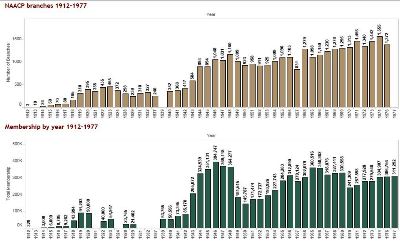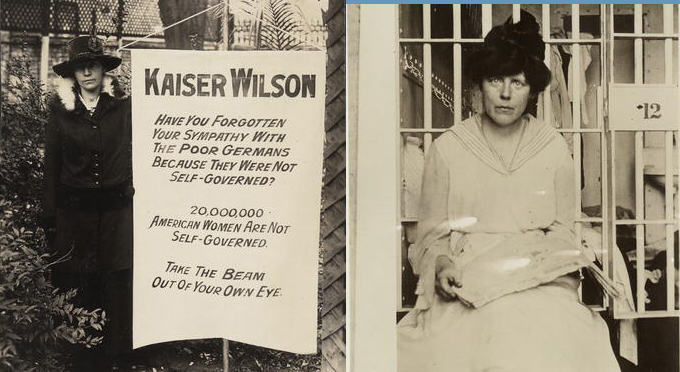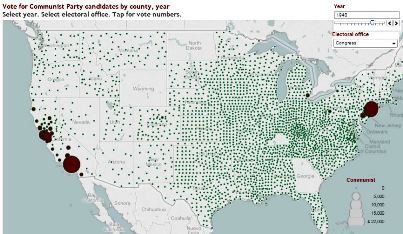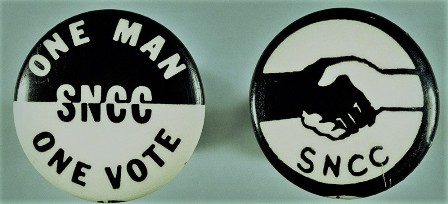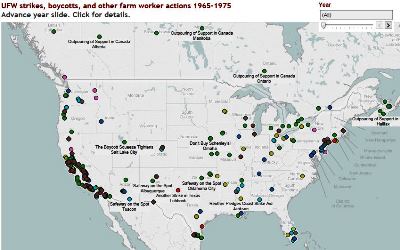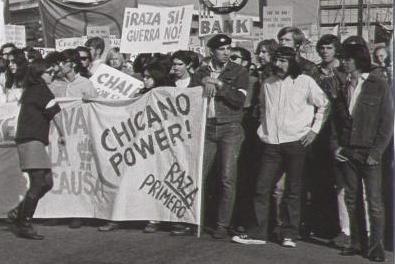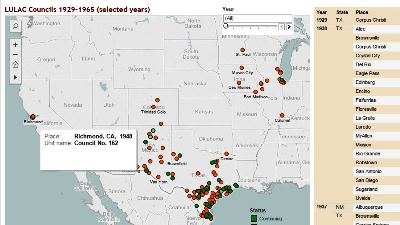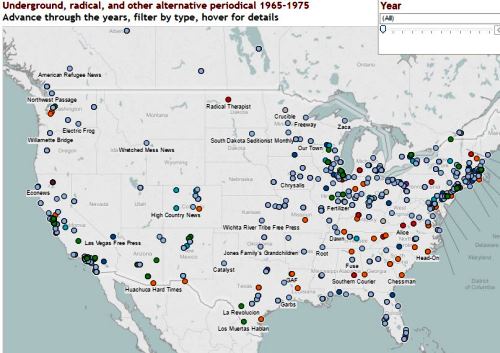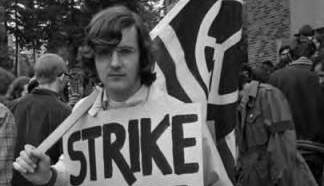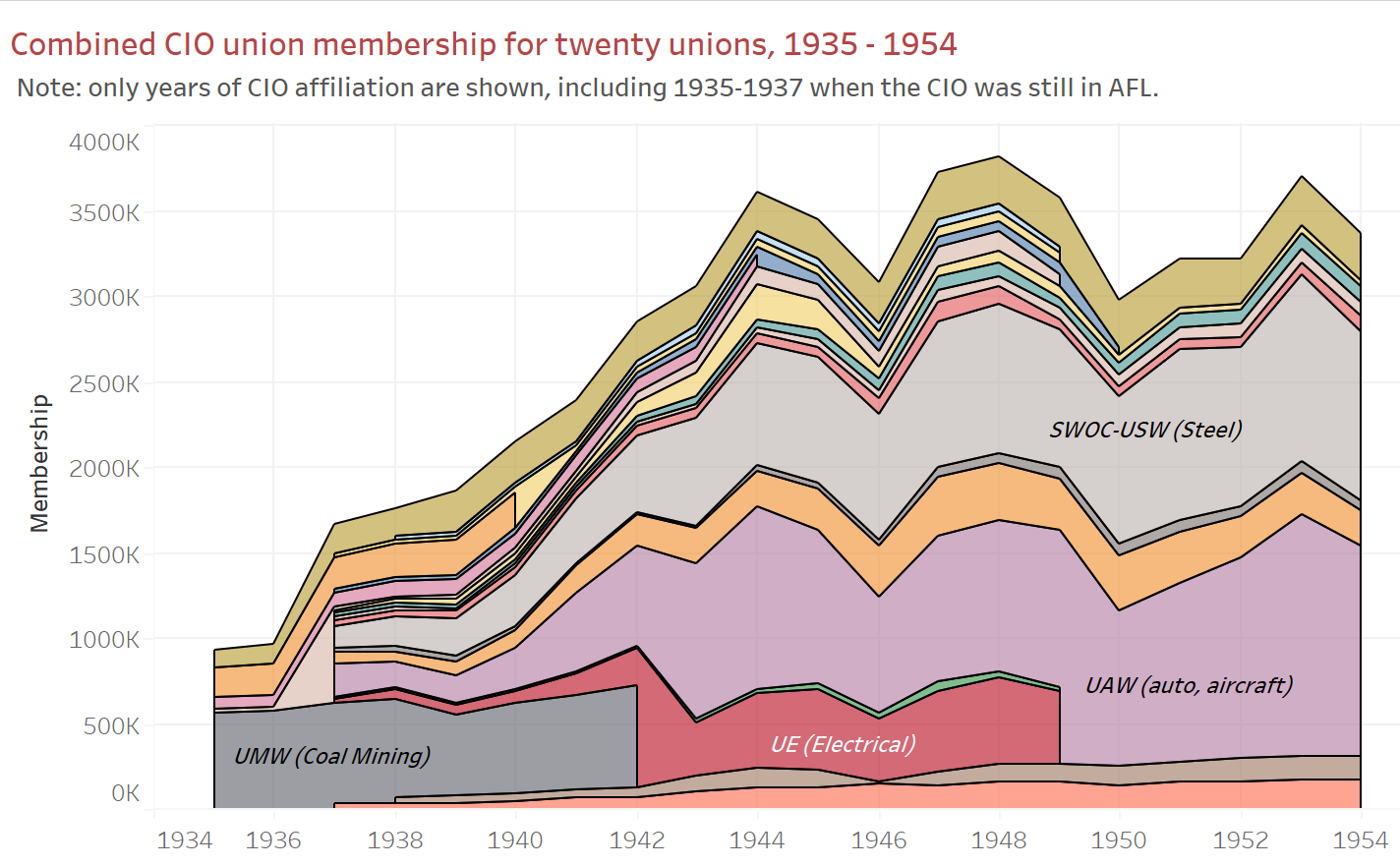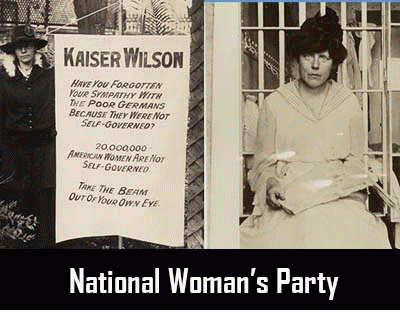
This project produces and displays free interactive maps showing the historical geography of dozens of social movements that have influenced American life and politics since the late 19th century, including radical movements, civil rights movements, labor movements, women's movements, and more. Until now historians and social scientists have mostly studied social movements in isolation and often with little attention to geography. This project allows us to see where social movements were active and where not, helping us better understand patterns of influence and endurance. It exposes new dimensions of American political geography, showing how locales that in one era fostered certain kinds of social movements often changed political colors over time.
We do this by developing detailed geographic data about each movement, identitying locations where membership, activities, or other measures of support were concentrated. The links above and below lead to over 120 interactive maps, charts, and data tables, with more to come. We started with maps and charts that show the activist geography of the Socialist Party, Industrial Workers of the World, and the Communist Party, then developed similar maps on Black Freedom movements: NAACP, Congress of Racial Equality, SNCC, and the Black Panther Party.
We have added a battery of visualizations showing the geography of Chicanx/Latinx movements: United Farm Workers (UFW), MEChA, Raza Unida Party, Brown Berets, League of United Latin American Citizens, hundreds of Chicano movement periodicals published between 1966 and 1977, and also maps of the Immigrant Rights Protests of 2006.
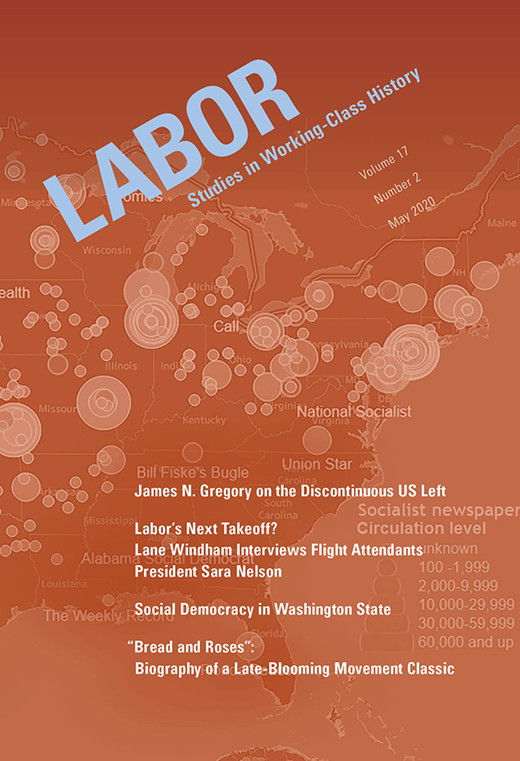
And we have mapped the activities of the Woman Suffrage movement: National Woman's Party 1913-1922 and an exciting complex of timelines and maps showing the state by state progress of women's voting rights from 1838-1919.
Another unit tracks the New Left and antiwar movements of the 1960s and 1970s. Also more than 2,000 Underground newspapers from the 1965-75.
Labor history is another focus. See the exciting maps and database documenting the 12,000 local assemblies of the Knights of Labor. We are working now on the early history of the CIO unions 1935-1950 with separate maps and data for the UAW, UE, ILWU, AMCW and other unions.
Project director James Gregory has recently published Remapping the American Left: A History of Radical Discontinuity in the journal LABOR: Studies in Working-Class History. Based on this project, the article develops new understandings about the dynamics of American radicalism. The American left has been more discontinuous and more innovative than its counterparts in most countries and operates in different ways. The essay maps five distinct left constellations over the last century and explores the question of how American radicalism has survived, how it has repeatedly reconstituted itself absent the supportive institutional apparatus of an electoral party. It is available free from the journal website linked here.
Here are more than two dozen interactive maps and charts that show the geography of Socialist Party activity. One set shows votes for SP candidates in every county. Another displays SP membership by state and year. A third maps the location of 380 newspapers associated with the Socialist Party. And we map the 353 towns and cities that elected socialists to office between 1904 and 1920.
|
|
These interactive maps locate more than 1,800 strikes, campaigns, arrests, and vigilante events involving the Industrial Workers of the World from 1905 to 1920. Events can be filtered by year or advanced in a month by month sequence. They can be filtered by state or type of event. Hover to see short descriptions. A second set maps more than 900 local unions affiliated with the IWW with filtering by industry and date of operation. |
|
From an early date, the NAACP was a grass roots organization with a membership that expanded across the nation. These interactive maps and charts show the growth of the NAACP from a single branch with a few members in New York City to 80 branches by 1917, to 400 branches in 1923, then surging to more than 1,000 branches and 300,000 members during World War II, and then the regional surge into the South in the 1950s and 1960s. |
|
The accomplishments of the National Woman's Party are legendary. In just seven years, the NWP achieved what most thought impossible, securing an amendment to the US Constitution guaranteeing women the right to vote. Here are maps, a timeline of more than 400 NWP meetings, picket lines, and arrests, and a year-by-year history of NWP. |
|
These maps show the fight for votes year by year and state by state as women activists and their allies introduced legislation that often failed and at other times yielded only partial voting rights, often limited to school elections or in some cases only municipal or the presidential election. Here we show the outcome of 249 voting rights measures considered by state legislatures. |
|
The geography of the CP was different than earlier radical movements. Here are several maps and charts that show where party support was concentrated. We show changing party membership by region and map the number of votes won by CP candidates in elections county by county. In close detail, CP activities in Chicago are mapped. |
|
The Student Nonviolent Coordinating Committee was arguably the most dynamic and influential of the 1960s new left and civil rights era organizations. We map more than 500 SNCC sit-ins, boycotts, and other actions and explore our yearbook/ database of SNCC actions |
|
Founded by black and white students at the University of Chicago, the Congress of Racial Equality pioneered key tactics of the modern civil rights movement. Here we map more than 600 demonstrations organized by CORE and show the changing activist geography as the organization first attacked segregation in northern cities, then moved south sponsoring Freedom Rides and other forms of civil disobedience. |
|
Founded in Oakland, the Black Panther authorized only 12 additional chapters. Still the Party staged actions across a wider geography. Here are maps and timelines showing more than 500 BPP actions. In addition, we show in detail the six metropolitan areas where the Panthers enrolled that largest number of members and made the greatest impact: Oakland-SF Bay Area; New York; Chicago; Los Angeles; Seattle; Philadelphia. |
|
When ethnic Mexican farm workers led by Cesar Chavez joined with Filipino American workers led by Larry Itliong in 1965 to strike grape growers in Delano, California, the modern farm workers' movement was born. Here we map more than 1000 strike actions, boycotts, and other UFW related events showing the movement's support across the United States and Canada. |
|
Chicano students began to organize on college campuses in the late 1960s, forming organizations with various names. In 1969 most of these organizations merged forming El Movimiento Estudiantil Chicano/a de Aztlan (MEChA). MEChA spread in stages and as of 2012 claimed more than 500 chapters. Here are year-by-year maps. |
|
Here are more than 300 newspapers and newsletters associated with the surge in Chicano activism in the 1960s and 1970s. Some were published by movement organizations, others served local communities. |
|
Following the so-called “Chicano takeover” of Crystal City’s school board and city council in 1970, activists launched Raza Unida Party, running candidates in local and state elections in Texas and several other states. These maps show the growth and decline of RUP chapters and electoral campaigns. |
|
In the barrios of Los Angeles, Chicano youth founded the Brown Berets in 1967, modeled after the Black Panther Party. The organization was dedicated to combatting police brutality and racism, but some chapters also demanded education, job, and housing equality. By 1969, there were 29 chapters mostly in California with a few units in Colorado, Michigan, Minnesota, New Mexico, Texas, and Washington.
|
|
LULAC was founded in Corpus Christi in 1929 and added 18 councils the next year, all but one in Texas. With World War II, LULAC began to extend its reach to California, Arizona, New Mexico, and later Colorado, claiming 82 chapters by 1955. The next decade brought LULAC new influence and a new geography, reflecting the Tejano diaspora that was now spreading into the upper Midwest. |
|
The social movements of 1960s and 1970s would not have been possible without the underground press, an explosive new media system that spread through hundreds of communities. Explore the history and geography of alternative media system with (1) interactive maps and charts that show 2,600 underground/ alternative periodicals from the decade between 1965 and 1975; (2) a filterable database of these publications. |
|
The May 1970 antiwar strikes comprised one of the largest coordinated sequences of disruptive protests in American history, with walkouts spreading across more than 650 campuses involving hundreds of thousands of students. This followed the news of a secret invasion of Cambodia and days later the massacre of unarmed students at Kent State.
|
|
The Students for a Democratic Society (SDS) was one the most influential radical organizations of the 1960s and remains closely associated with the term "New Left." Founded in 1960, the organization took on a new mission after the Johnson administration escalated the war in Vietnam, launching a campaign of antiwar actions. Here we map the expansion of SDS chapters from 11 in 1962 to more than 300 by early 1969
|
|
Millions of young men found ways to avoid conscription during the Vietnam war. Others, women as well as men, committed themselves to openly resisting the draft. They burned or surrendered draft cards, refused induction, and staged disruptive protests at draft boards and induction centers, employing in some cases tactics of peaceful civil disobedience, in other cases damaging property and battling with police. Here we map draft resistance actions that received publicity in major newspapers in the years between 1965 and 1972.
|
|
Based on data assembled by James Lewes, these maps and charts locate 768 periodicals associated with the GI antimilitarist movement in the era of Vietnam war. By 1970, antiwar periodicals for GIs were available near most military bases in the US and at bases in Europe and Asia, especially in West Germany and Japan.
|
|
Denied access to major media, labor and radical movements have published thousands of periodicals, constituting an alternative press that was vital to these movements and important to the history of American journalism. Here we explore this history and show the geography of radical journalism across nearly a century with maps and databases that include more than 1,000 publications linked to the American Federation of Labor, the Socialist Party, Industrial Workers of the World, Anarchist movements in the decades between 1880 and 1925. |
|
Between February 14 and May 1, 2006, some four hundred protest actions in defense of immigrant rights took place in more than two hundred U.S. cities and towns, involving an estimated six million participants. These events were part of a mass mobilization in response to a draconian immigration bill, the "Border Protection, Antiterrorism, and Illegal Immigration Control Act" (HR 4437) that passed the House of Representatives in December 2015. Catching journalists by surprise, demonstrations rolled across the country.Some of the protests were held during weekday work hours and promoted as a part of a “Day without Immigrants” strike, featuring “no work, no school, no shopping,” |
|
The CIO transformed American labor and American politics. Defying the American Federation of Labor's commitment to craft unionism, the Committee for Industrial Organization was launched in 1935 by leaders of the United Mine Workers and other AFL unions who embraced industrial union organizing strategies. The goal was to build unions in core industries like steel, auto, aircraft, electrical appliances, meat packing, tires, and textiles that had blocked organizing efforts at every turn.
Here we explore the history and geography of the CIO unions from 1935-1954 with maps and membership data showing the spread of locals and membership density in hundreds of cities for these key unions: United Auto Workers (UAW), United Electrical Workers (UE), Amalgamated Clothing Workers (ACWA), International Ladies Garment Workers (ILGWU), International Longshore and Warehouse Union (ILWU), International Typographical Union (ITU), and International Woodworkers of America (IWA). |
|
Directed by Professor James Gregory, the project has been supported by Digital Humanities grants from the Walter J. Simpson Center for the Humanities, by the History Department Digital History Initiative and Hanauer Fund, and by the Harry Bridges Center for Labor Studies, all at the University of Washington. The Mapping American Social Movements Project includes two stand-alone websites IWW History Project--The Industrial Workers of the World 1905-1935 and Upton Sinclair's End Poverty in California Campaign. These are collaborative efforts, depending upon contributions from many scholars. [more]
|




